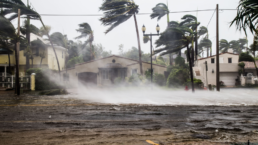North Carolina was once a climate leader, but more than a decade of Republican and corporate obstruction left the state ill-prepared for the historic disaster.
By Lucy Dean Stockton and Freddy Brewster, The Lever
In the years before Hurricane Helene ravaged North Carolina last week, the state’s Republican lawmakers and corporate interests continually fought climate adaptation and mitigation measures that could have helped communities withstand the storm’s tidal surge, hurricane-force winds, and widespread flooding.
While North Carolina was once a national leader in renewable energy and climate change resiliency policies, that changed in the early 2010s when Republicans secured control of both chambers of the state’s legislature and a former utility company executive moved into the governor’s mansion. Since then, GOP politicians and their big-business allies have sabotaged climate resiliency projects, delayed plans to embrace renewable energy, and stonewalled efforts to prepare the state for stronger storms and a rising sea.

“The Republican approach to climate change has been much like an ostrich with its head in the sand,” said Dan Crawford, director of governmental relations at North Carolina’s League of Conservation Voters, a nonprofit group focused on environmental policy. “And if you’re ignoring all of these things that are happening in the world, it’s going to have effects.”
On Sept. 27, Hurricane Helene, a Category 4 hurricane, wrought havoc throughout the state. On the coast, homes were washed into the ocean ahead of the hurricane making landfall. And in western North Carolina, the storm caused what one county executive called “biblical devastation.”
Using increasingly precise attribution science, experts are already finding evidence that climate change fueled Helene’s destruction, including that warmer ocean temperatures likely exacerbated the storm’s rain. The most recent national climate assessment, completed last year, found that the amount of precipitation in the most intense rainstorms has increased 37 percent in the Southeast since 1958.
Recent Posts
Nigerian Village Bombed by Trump Has ‘No Known History’ of Anti-Christian Terrorism, Locals Say
December 28, 2025
Take Action Now “Portraying Nigeria’s security challenges as a targeted campaign against a single religious group is a gross misrepresentation of…
How Effective Are Protests? Historians Say: Very.
December 27, 2025
Take Action Now Protests change the protesters, their communities and the nation. From emancipation to women’s suffrage, civil rights and BLM, mass…
The United States’ Hidden History Of Regime Change—Revisited
December 26, 2025
Take Action Now The truculent trio—Trump, Hegseth, and Rubio—do Venezuela.By Barbara Koeppel, The Nation Since the early 20th century, the United…
The “President Of Peace” Prepares For War
December 23, 2025
Take Action Now The Donroe Doctrine Hits HomeBy William D. Hartung, Tom Dispatch Earlier this month, the Trump administration released its new…




